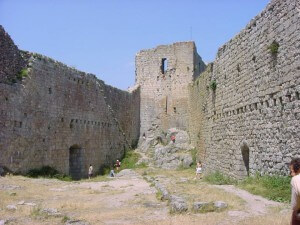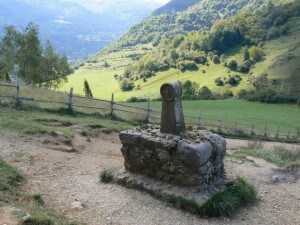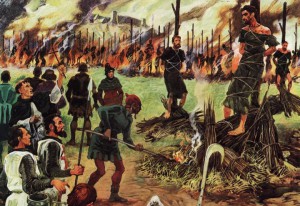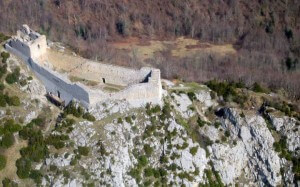
France: The Secret of the Montségur Castle
 02. 02. 2024
02. 02. 2024

"A cursed place on a holy mountain," says folk superstitions about the pentagonal castle of Montségur. The southwest of France, where it is located, is a truly magical place, full of magnificent ruins, legends and legends about the "virtuous knight" Parsifal, the Holy Grail and, of course, the magical Montségur. Due to its mysticism and mystery, this place has nothing to do with the German mountain Brocken. What tragic events does Montségur actually owe its reputation to?
"Then I will tell you," the monk said, "He who is to sit down in this place has not yet been conceived and not conveyed. But not a year will pass, and the one who sits on the fatal stool will be conceived and will receive the Holy Grail.
Thomas Malory. The Death of Arthur
During the stubborn and bloody fighting in 1944, the Allies occupied the conquered German positions. Many French and English soldiers fell at a strategically important height in an attempt to take control of Montségur Castle, where the remnants of the 10th German Wehrmacht Army were fortified. The siege of the castle lasted 4 months. Eventually, after intense bombing and with the help of paratroopers, the Allies launched a decisive attack.
The castle was practically destroyed to the ground. However, the Germans still resisted, although their fate had already been decided. As the troops of the Allied armies approached the walls of Montségur, something very strange happened. A large banner with an ancient pagan symbol, a Celtic cross, appeared on one of the towers.
The Celts resorted to this old ritual only if they needed the help of higher forces. But everything was in vain and nothing could help the occupiers.
This event was not the only one in the long history of the castle, full of mystical secrets. It is no coincidence that the name Montségur means safe mountain.
 850 years ago, one of the most dramatic episodes in European history took place at Montségur Castle. The Inquisition of the Holy See and the army of King Louis IX of France. they besieged the castle for almost a year and failed to deal with the two hundred Cathars who were fortified in the castle. The defenders of Montségur could give up and leave in peace, instead preferring to enter the border voluntarily, thus preserving the purity of their mysterious faith.
850 years ago, one of the most dramatic episodes in European history took place at Montségur Castle. The Inquisition of the Holy See and the army of King Louis IX of France. they besieged the castle for almost a year and failed to deal with the two hundred Cathars who were fortified in the castle. The defenders of Montségur could give up and leave in peace, instead preferring to enter the border voluntarily, thus preserving the purity of their mysterious faith.
To this day, we do not have a clear answer to the question of where the Qatari heresy came from in southern France. The first traces of Cathars appeared in these regions XI. century. At that time, the south of France belonged to the County of Languedoc, which stretched from Aquitaine to Provence and from the Pyrenees to Creysse and was independent.
This considerable territory was ruled by Count Raimond VI of Toulouse. Nominally, he was a lazy man of the French and Aragonese kings and also of the emperor of the Holy Roman Empire, but in terms of nobility, wealth and power he could fully compete with them.
While the north of France was dominated by the Catholic Church, the dangerous Cathar heresy spread more and more on the estate of the Counts of Toulouse. According to some historians, this faith came to France from Italy, where it came from Bulgaria from the Bogomils, and the Bulgarian Bogomils adopted Manichaeism from Asia Minor. The number of those who then began to call them Cathars (from the Greek pure) grew like mushrooms after the rain.
"There is not just one god, but there are two who are vying for control of the whole world. They are the god of good and the god of evil. The immortal human soul points to the god of goodness, but the mortal box is attracted to the dark god, ”so many Cathar teachings. And they considered our world on earth to be the kingdom of Evil and the heavens that inhabit human souls, the place where Good rules. Therefore, the Cathars could easily say goodbye to life and look forward to the transition of their souls to the kingdom of Good and Light.
Strange people wandered along the dusty roads of France in the hoods of Chaldean star transporters and kutna, girded with a rope - cathars preached their teachings everywhere. Those of them who were called "perfect" took on the task of spreading the faith and devoted themselves to asceticism. They completely broke the ties with the previous life, gave up all property and observed both Lent and ritual regulations and ceremonies. Instead, all the mysteries of the faith and its teachings were revealed to them.
The second group of Cathars belonged to the so-called "common", non-invincible, and ordinary members. They lived a normal life and  they sinned like everyone, but they kept the commandments they had taught them "perfect".
they sinned like everyone, but they kept the commandments they had taught them "perfect".
The new faith was very readily accepted by knights and nobility. Most noble families in Toulouse, Languedoc, Gascony, and Rousillon became her followers. They did not recognize the Catholic Church because they considered it the product of the devil. This attitude could only lead to bloodshed…
The first encounter between Catholics and heretics took place on January 14, 1208, on the banks of the Rhone, when one of Raimond VI's soldiers crossed the river. he fatally wounded one of the apostolic nuncias with a spear. The dying priest whispered to his killer, "May the Lord forgive you as I forgive you." But the Catholic Church did not forgive. In addition, Philip II was already fond of the rich Toulouse county. and Louis VIII. and dreamed of joining this rich country to their states.
The Toulou Earl was declared to be heretics and followers of Satan. And the Catholic bishops raised their voices: "The cats are disgusting heretics! It is necessary to eradicate them with fire so that there is not even one seed ... "For this purpose, the Holy Inquisition was created by the Pope to subordinate the Dominican order (Dominicanus - Domini canus to the Lord's dogs).
Thus a crusade was declared, which was not for the first time directed against the Gentiles but against the Christians. It is interesting that the question of the soldier, how to distinguish the Cathars from the right Catholics, replied the papal legate: "Kill them all, God will know you!"
Crusaders plunged the blossoming south of France. Only in the city of Beziers, where the people gathered at the church, 20 was murdered by a thousand people. Cathars discharged all over the cities and Raimond VI. its territory.
In 1243, Montségur Castle, their sanctuary turned into a military fortress, remained the only Cathar refuge. All the "perfect" survivors gathered here. They had no right to use weapons because they were considered a symbol of evil in their teachings.
However, this small (two hundred people) and unarmed crew was able to resist the attacks of an army of ten thousand crusaders for almost 11 months! We learned about what was happening on a tiny piece at the top of the mountain from the records taken during the interrogation of the defenders. They contain the admirable courage and perseverance of the Cathars, which still amazes historians. And mysticism is also present in them.
Bishop Bertrand Marty, who commanded the defense of the castle, knew very well that he would not be defended. Therefore, before Christmas 1243, he sent two faithful servants to take something very valuable from the castle. Rumors are circulating that this treasure is still hidden in one of the many caves of County Foix.
- March 1244, when the position of the defenders became unsustainable, the bishop began negotiations with the Crusaders. He did not intend to build the fort, but he needed time, and he achieved it. During the two weeks of the armistice, the Cathars managed to reach a heavy catapult to the rock plateau. And the day before the surrender, an almost incredible event is taking place.
 At night, the four "perfect" descend a rope from a 1200-meter-high rock and take the package with them. The Crusaders hurried to pursue, but the fleeing seemed to dissolve in the air. After a while, two of the refugees appeared in Cremona and proudly said that they had succeeded in their task. But we don't know what they saved then.
At night, the four "perfect" descend a rope from a 1200-meter-high rock and take the package with them. The Crusaders hurried to pursue, but the fleeing seemed to dissolve in the air. After a while, two of the refugees appeared in Cremona and proudly said that they had succeeded in their task. But we don't know what they saved then.
But hardly cats, fanatics, and mystics risked their lives for gold and silver. And what kind of expense could the four desperate "perfect" take away? So the treasure of the Cathars had to be of another kind.
Montségur has always been a holy place for the "perfect". They built a pentagonal castle on top of the mountain after obtaining permission to rebuild from the previous owner Raimond de Pereille, his fellow. Here the Cathars performed their rites and protected the sacred relics.
The walls with loopholes on Montségur were oriented according to the sides of the world, similar to Stonehenge, and therefore the "perfect" could calculate which days the solstices would fall on. The architecture of the castle looks a bit strange. Inside the fortifications you feel like a ship, at one end there is a low square tower, the long walls define a narrow space in the middle and lead to the "bow", where the walls break twice at an obtuse angle.
In August 1964, speleologists discovered some marks, scratches and a drawing on one of the walls, which turned out to be a plan of an underground passage leading from the foot of the wall to the gorge. When they opened the hall, they found skeletons with halberds. And a new question arose: who were the people who died underground? Under the foundations of the wall, explorers discovered several interesting objects with Qatari symbols.
A bee was displayed on the buckles and buttons. For the "perfect," it was the secret of an immaculate conception. A special lead tape 40 centimeters long and folded into a pentagon, which was the hallmark of the "perfect" apostles, was also found. The Cathars did not recognize the Latin cross and worshiped the pentagon - a symbol of scattering, dispersal of matter and the human body (from which the floor plan of Montségur probably emerges).
When the castle was examined by a well-known expert on the Qatari movement, Fernand Niel, he emphasized that the building itself was "the key to the ceremonies, a secret that the" perfect "took with them to the grave."
To this day, a large number of enthusiasts are looking for hidden treasure, gold and valuables of the Cathars in the area and on the mountain itself. But the researchers are most interested in what the four brave ones saved. Some assume that the "perfect" protected the Holy Grail. It is no coincidence that you can still hear this legend in the Pyrenees today:
"When the walls of Montségur were still standing, the Cathars protected the Holy Grail. But then Montségur found himself in danger, Lucifer's troops lay under his walls. They needed the Grail to put him back in the crown of their master, from which he fell when the fallen angel was cast down from heaven on earth. At the moment of greatest danger to Montségur, a dove descended from the sky and tore Mount Tábor with its beak. The Guardian of the Grail threw a rare relic into the depths of the mountain, which then closed and the Holy Grail was saved. "
Some believe that the Grail is the cup in which Joseph of Arimathea caught the blood of Christ, others believe that it was a meal at the Last Supper, and another view is that it is a kind of cornucopia. In the legend of Montségur, he is described as a golden statuette of Noah's ark. According to legend, the Grail has magical properties, it can cure people of serious diseases and reveal their secret knowledge. But the Holy Grail can only be used by those who have a pure heart and soul on sinners  summons disasters and calamities. Those who used it became saints, some on earth, others in heaven.
summons disasters and calamities. Those who used it became saints, some on earth, others in heaven.
Some scholars think that the mystery of the Cathars was the knowledge of secret facts from the earthly life of Jesus Christ. Perhaps they knew of his wife and children who had been transported south to Gaul after his crucifixion. According to legend, the Holy Grail contained the blood of Jesus.
Also included was Mary Magdalene, a mysterious figure who was apparently Jesus' wife. It is known that it came to Europe, and it would follow that the descendants of the Savior founded the Merovingian family, the Holy Grail family.
It is said that the Holy Grail was transferred from Montségur to the castle of Montréal-de-Sault, from where it was taken to one of the temples of Aragon. He was reportedly transferred to the Vatican, but no documents confirm this. Could it be that he returned to Montségur?
Apparently it was no coincidence that Hitler, who dreamed of world domination, searched hard and purposefully for the Holy Grail in the Pyrenees. German intelligence combed through all the sunken castles, monasteries, temples and caves in the mountains. But to no avail…
Hitler had high hopes of finding the Grail, intending to use the holy relic to reverse the unfavorable course of the war. But even if the Führer managed to find and control the Grail, it would hardly save him from defeat. Just as German soldiers did not save themselves in Montségur by erecting a Celtic cross. After all, according to legend, the sinful holders of the Grail and those who sow Evil and death are afflicted by the wrath of God.





 1
1